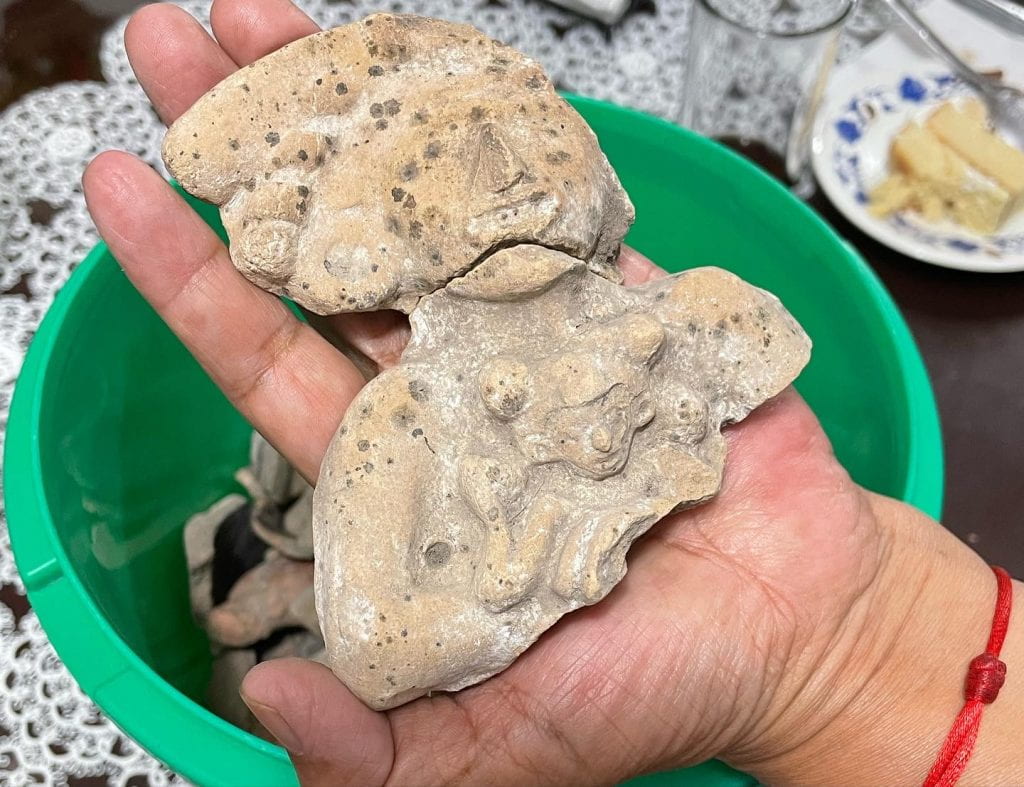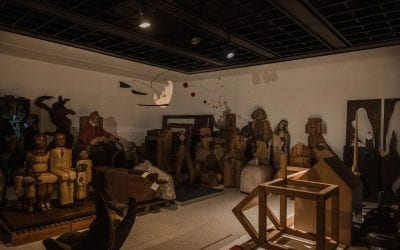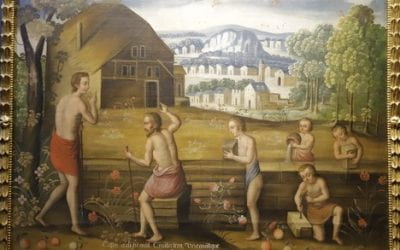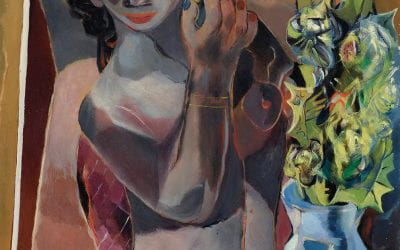Contested Patrimonio
The Politics of Repatriation in Mexico
In February 2022, President Andrés Manuel López Obrador revealed the letter he sent two years earlier to Austrian President Alexander Van der Bellen, requesting the return of the Penacho de Moctezuma, currently on display in Vienna’s Weltmuseum. This was not the first request for the repatriation of the headdress as Mexico’s national patrimonio, a legal regime that marks sub-soil resources like oil and mineral ores, but also ancient artifacts, as national property. Several Mexican heads of state, as well as cultural promoters, artists and activists had many similar demands over the last decades.
In January 2022, only a month before López Obrador’s press conference, Sebastián Arrechedera and Yosu Arangüena, two media activists, hacked the audioguides of the Vienna Museum. In a brilliantly orchestrated ruse, they substituted the museum’s official audioguides with identical apparatuses containing the recording Audioguía de la verdad. This version featured the voice of Xokonoschtletl Gómora, a neo-Aztec danzante who is the founder of the Asociación Civil Yankuik Anahuak and one of the most vocal activists working towards the Penacho’s return. Using guerrilla-like tactics, the action spoke directly to museum visitors’ ears, subverting the institution’s narrative from within. At the same time, the action powerfully conveyed that many in Mexico, not just the Mexican state, hold deep-seated claims over the Penacho (NPR’s Radio Ambulante made a podcast about some of these).

The Penacho. Photo Courtesy of Wikipedia Commons
Although little is known regarding the Penacho’s history and how it made its way to Europe, it has become the quintessential object that signals the enduring violence suffered by Mexico in the wake of European colonialism. First appearing in the late-16th century in a list of objects at the Ambras Castle at Innsbruck, the Penacho was later incorporated into Vienna’s Museum für Völkerkunde, which eventually became the Weltmuseum Wien. Over the centuries, the Penacho has been the center of unresolved controversies as to whether it in fact ever belonged to the last Aztec emperor; whether it was stolen or gifted, to and by whom; whether it was in fact a headdress at all, or a cloak, a mantle, a crown or another form of regalia; and even whether the surviving artifact could even be considered “Aztec,” given the many reworkings and restorations it has been subjected to.
In 2012, following a binational study (see Jaime Kuri’s documentary about the process), Austrian and Mexican conservators specializing in featherwork restored the Penacho. They determined that, given its fragile state, returning it to Mexico would seriously put it at risk, that the vibrations resulting from its transport over just a few hours would cause the equivalent of 200 years of wear-and-tear. This was not set forth as an impossibility for its return, but as a challenge that called for engineers rather than museum professionals to design the means to move it without threatening its conservation.
Whether or not the Penacho can or should be returned to Mexico has become a hot topic on social media and even in academic publishing where scholars have weighed in on the debate. I personally believe that museums such as Vienna’s Weltmuseum and other self-described “world museums” must reckon with their role in extending the violence of colonialism in the present and return objects that are meaningful to countries and communities in former colonies or amongst people and places that have endured violence and long-standing extractivism. In the specific case of the Penacho, it should be up to the Austrian institutions to design the means necessary to ensure its safe return to Mexico—or to accept that the artifact’s conservation is perhaps less important than its repatriation. After all, the laws of entropy will prevail and all things, and especially things made of feathers and organic matter, will inevitably decay sooner or later, whether on a plane to Mexico or inside a temperature controlled, dimly lit and hermetically sealed glass case in Vienna.
However, the ubiquity of the controversy over the Penacho in Mexico is surprising given the country’s own fraught histories of collecting and patrimonial politics. Government officials, Mexican heritage institutions charged with caring for national patrimony, as well as the Mexican press, have been fast to accuse the museum and Austrian authorities of refusing to return the Penacho. Yet, at the same time, they ignore and even silence the histories of objects that have in fact been repatriated to Mexico over recent and less recent times. Far from public knowledge, the examples of successful repatriation of Mexican patrimony are only known to a few people, mostly specialists such as museum professionals, archivists and historians. In some cases, this might be because triumphalist narratives surrounding repatriation do not sit well with the actual actors and motivations involved in negotiating and eventually achieving many objects’ return.
As restorers Laura Filloy and Maria Olvido Moreno and historian Miruna Achim have shown, this is certainly the case with the first ancient Indigenous artifact to have returned to Mexico from European collections, a feather chimalli repatriated in 1866 by none other than Maximilian, the Hapsburg emperor imposed by Napoleon to rule Mexico and a figure construed as one of the imperialist villains of Mexican history. Miguel Angel Quemain has shown how Maximilian’s role as an agent of repatriation was equally silenced in another case, even more tied to Mexico’s foundational history : the only surviving copy of Mexico’s Declaration of Independence that was repatriated at his behest after it was stolen and exported to France where it remained for decades; the other was lost in a devastating fire in Mexico in 1909.

Image of Chimalli next to portrait of Maximilian, National History Museum, Castillo de Chapultepec – Photo by Cynthia Talavera / Infobae.
Other examples are even more striking because, unlike the former two, they could very easily have been spun into nationalist narratives glorifying Mexican heroes, diplomatic successes and the perseverance of national heritage institutions and officials. For example, in the nation’s most important museum, the Museo Nacional de Antropología, several objects are currently on display (and have been for decades) that were successfully repatriated, some even in the recent past, from important collections following long processes of negotiation and exchange.
At least four cases feature objects that constitute the museum’s most prized pre-Columbian holdings on show in three different exhibition halls. In the Maya Hall, Filloy and Christina Bueno have documented the 1909 return of one of the panels from Palenque’s Temple of the Cross from the United States; the Placeres stucco-covered monument was also returned decades later by the Metropolitan Museum of Art in New York in 1969. In the Teotihuacan galleries, following a collaborative restoration project, a set of illegally exported murals were returned in the 1980s from the De Young Museum in San Francisco (Kathleen Berrin edited a volume on the case, more recently studied by Matthew Robb and Rita Sumano). In the Golfo Hall, three figurines from La Venta Offering 4 were returned by the Smithsonian Institution in 2010, after having been given on permanent loan by Mexican officials in the 1950s and following almost 20 years of negotiations (Diana Magaloni and Filloy published a catalog documenting the case). Despite having been the subject of important scholarship, none of these objects has any label or reference to the fact that they were repatriated, who participated in the process, nor what the negotiations for their return entailed. They have simply been incorporated seamlessly into the storyline of the museum and its glorification of Mexico’s pre-Columbian past with very little interest in how this past has been produced through research and archaeological excavation, as well as through efforts by many leading to objects’ return.
The Wagner Murals in the Teotihuacan Hall of the Museo Nacional de Antropología and their label Photos by Sandra Rozental, 2022.
The Museo Nacional de Antropología has itself been reluctant to reckon with its own histories of collecting, particularly given its holdings from private collections that might have originated from purchases that fueled the illicit trade in antiquities and looting of ancient sites. In the 1960s, when the museum was being built, a large part of the collections used to fill its galleries were purchased, exchanged or accepted as donations from private collectors with little regard for their provenance.
This brings to light another aspect of the contradictory nature of the Mexican state’s demand for the Penacho’s return. The insistence that Austria return the Penacho naturalizes the Mexican state’s own extractivist politics, reproducing colonial forms of appropriation within the country’s national borders. For many in Mexico, many of the artifacts currently on display, as well as the demarcation of sites and monuments as national patrimonio administered under the auspices of the official bodies such as the Instituto Nacional de Antropología e Historia (INAH) have also resulted from state-sanctioned plunder and violent dispossession, ignoring or in fact destroying their significance and vital forces for multiple local actors and communities.
Perhaps the most famous example is one I have written extensively about regarding the relocation of a colossal ancient rain deity that came to be known as “Tlaloc” despite doubts about its identification, from the town of San Miguel Coatlinchan to the Museo Nacional de Antropología. The 167-ton monolith was removed from the town in 1964 on a purpose-built truck using state-of-the-art engineering. Following military intervention to quash town residents’ efforts to sabotage its extraction, it was taken by force and repurposed as a public monument standing in front of the museum on the Paseo de la Reforma. A plaque at the monolith’s feet states that it was “generously donated” by the residents of the town to the museum. Although much less spectacular, other examples abound that reveal how Mexico’s own national collections were formed as a byproduct of state-sanctioned violence, extractivism or disrespect for local relationships and uses of ancient artifacts, monuments and sites.

The stone carving form Coatlinchan on Reforma and plaque Photo by Sandra Rozental, 2022.
On February 21, 2021, a year before López Obrador made his request for the Penacho’s return with such pomp and circumstance, an ancient moai made its return journey from Santiago de Chile to the island of Rapa Nui. The moai had been exhibited in Chile’s National Museum of Natural History since 1878. It is now the subject of the most complex repatriation process undertaken by the country’s institutions as part of the Ministry of Culture’s commitment to repatriate ancestral objects and human remains to Indigenous communities. The moai, one of three that made up the museum’s holdings, was selected to spearhead the Programa de Repatriación Ka Haka Hoki Mai Te Mana Tupuna, sparked by a claim for the return of ancestral objects filed in 2018 by Rapa Nui’s CODEIPA (Consejo de Ancianos y Comunidad Indígena Ma’u henua). The moai was greeted on the island with chants, dances and offerings, as it made its way to the Museo Antropológico Padre Sebastián Englert, where it was put on public display, not as an object of art or national patrimony, but as a venerated ancestor.

Image of moai return Photo credit: https://www.museorapanui.gob.cl
The recent return of the moai marks a watershed in Latin American heritage politics where the enduring legacies of indigenismo naturalized appropriation of indigenous artifacts and human remains, or made them into curiosities, scientific specimens or natural history collections following violent histories of genocide and forced acculturation. As museum collections, state-sanctioned institutions claimed such objects as national patrimony preserving them for posterity. With very few exceptions, many Latin American countries have requested the return of collections from museums abroad and in many cases successfully repatriated them, but to state-run museums, rather than to the communities from which they were taken.

Ancient artifacts kept by a resident of Coatlinchan, Mexico Photo by Sandra Rozental, 2022.
In Mexico, perhaps the attention given to the Penacho’s possible return might lead the country’s heritage institutions and museum professionals to reformulate the country’s own politics of appropriation and the ensuing dispossession of communities thriving on national territories. Mexican museums might then engage in their own forms of reckoning to face the legacies of colonial violence implicated in making and sustaining the nation-state and its collections. Rather than requests for objects to return from abroad and be seamlessly incorporated in the midst of these collections, the Penacho controversy might open debates in Mexico regarding where and to whom objects made by ancient Indigenous peoples might be returned. Assuming that the Penacho’s legitimate home and appropriate place is in the halls of the Museo Nacional de Antropología is another way of naturalizing and silencing state-enforced violence and dispossession.
Sandra Rozental, Associate Professor in the Humanities Department, Universidad Autónoma Metropolitana-Cuajimalpa, co-editor with Miruna Achim and Susan Deans-Smith of Museum Matters: The Making and Unmaking of Mexico’s National Collections (2021) and co-director with Jesse Lerner of the documentary feature The Absent Stone.
Related Articles
The Odalisque in Red Pants
The location, characters and what was about to happen are worthy of a thriller: in a room in the luxurious Hotel Loews in Miami, two supposed art dealers, Pedro Antonio Marcuello Guzmán and María Martha Elisa Ornelas Lazo, waited for some potential art buyers for something huge they had been offering for a while.
Returning Our History: Repatriation of Peruvian Cultural Patrimony
It was August 2017 and I had just become the General Director in Defense of Cultural Patrimony in the Peruvian Ministry of Culture. An e-mail from a special Federal Bureau of Investigations (FBI) agent specialized in crimes against cultural patrimony suddenly came across my desk.
How Museums Shape (Post)Colonial Identities in Ecuador and Beyond
As a study abroad student in Quito, Ecuador, about ten years ago, I wandered through the living spaces of Eduardo Kingman (1913-1997), an influential modernist painter.






